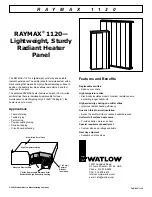
70277 Rev. C 04/07
MAINTENANCE AND STORAGE
WARNING. To prevent personal injury, unplug the heater
from the wall outlet before servicing.
For maximum efficiency and trouble-free service, make the
following periodic maintenance, cleaning and inspections.
DAILY SCHEDULE
1.
GENERAL. Make general visual inspection of heater for
loose or damaged parts. Check nuts and bolts to insure
against looseness caused by vibration or rough handling.
Damaged parts should be repaired or replaced before using
heater again. Check heater operation to be sure it is
operating normally (See "Servicing" section for description
of normal operation).
2.
FILTERS. Dirty air or fuel filters will cause an imbalance in
the air-fuel mixture. The best indication that this condition
exists is an increase in odors or difficulty getting your
heater to ignite. This heater should never be operated
without the filters in place. If required, clean filters as
described under "500 Hours" and "Annual Schedules".
500 HOUR SCHEDULE
1.
AIR INTAKE FILTER. Remove and wash the filter element
with a mild detergent, dry thoroughly and replace. Do not
oil the filter element. If your heater is used where there is
considerable dust or dirt, clean as often as necessary
(approximately every 50 hrs.).
2.
REMOVE DUST. Clean heater twice a season (more often
under dusty conditions). Remove accumulated dust from
the transformer, burner, motor and fan blades with
compressed air. Wipe area clean with a clean dry cloth.
Inspect area to insure all foreign materials are removed,
especially around the burner and combustion area.
3.
CAD CELL. Clean the glass portion of the cad cell with a
soft dry cloth.
4.
NOZZLE. Accumulation of dirt from fuel and carbon from
the compressor vanes will eventually fill up the passages in
the nozzle, resulting in reduction of fuel and air flow.
Pressure will gradually increase giving improper fuel-air
mixture and excess odor and smoke. If this occurs, replace
the fuel nozzle.
5.
FUEL TANK. Clean twice a season (during frequently used
periods, clean twice a month). Drain and flush the fuel tank
with clean fuel oil.
ANNUAL SCHEDULE
1.
AIR OUTPUT FILTER. Remove the air output filter and tap
the contaminated side gently on a solid object to remove
contaminates. Compressed air or liquids should not be used
to clean this filter. Reinstall cleaned filter in filter body in
the same position as it was when removed. If the filter
appears extremely dirty, replace it with a new filter of the
same type. When replacing the filter cover, be sure the
gasket is firmly in place and the screws in the filter cover
are tight to prevent air leaks.
2.
FUEL FILTER. Remove the fuel filter from fuel line and direct
compressed air through the filter in the opposite direction
of fuel flow. Safety glasses should be worn when using
compressed air.
3.
AIR AND FUEL LINES. If the air or fuel lines are removed
during cleaning, be sure all connections are tight before
operating unit.
4.
AIR PRESSURE SETTING. The air pressure has been properly
set at the factory. If the air pressure is out of adjustment, it
will most likely be caused by dirty air filters, a partially
plugged nozzle, an air leak in the system or improperly set
pressure. If adjustment becomes necessary, first determine
the proper pressure setting for your heater which is printed
on the serial label located on the fuel tank. With a full fuel
tank, remove the plug (part #33 from the exploded-view
drawing on page 9) from the air filter cover and attach a 0 -
15 PSI pressure guage. Start the heater and note the
pressure reading. If the pressure is low, slowly turn the
pressure adjusting screw in (Clockwise) until the correct
pressure is obtained. If the air pressure is high, turn the
adjusting screw out (counterclockwise) until the pressure is
correct. When correct pressure is reached, unplug the
heater, remove the gauge and replace the plug.
6
Enerco Group, Inc. | Kerosene Forced Air Heater
Operating Instructions and Owner’s Manual
STORAGE
Store the heater in a dry location free from fumes or dust.
At the end of each heating season, clean the heater as described
in the MAINTENANCE section. Drain and flush the fuel tank with
clean fuel. The manufacturer recommends completely filling the
tank with fuel for extended storage to minimize condensation
inside the tank.
SERVICING
A hazardous condition may result if a heater is used that has
been modified or is not functioning properly.
When the heater is working properly:
*
The flame is contained within the heater.
*
The flame is essentially yellow.
*
There is no strong disagreeable odor, eye burning or other
physical discomfort.
*
There is no smoke or soot internal or external to the heater.
*
There are no unplanned or unexplained shut downs of the
heater.




























